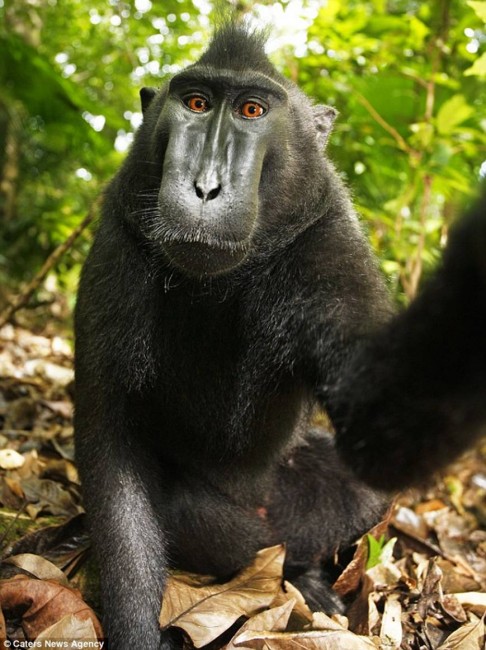Andrew Charlesworth at The Conversation nutshells:
Whilst visiting a national park in North Sulawesi wildlife photographer David Slater had his camera stolen – not by a thief, but by an inquisitive crested black macaque. The resulting selfies are causing controversy and raising questions about the ownership of images on the web. So just who does own the copyright when a monkey gets trigger-happy on your device?
Slater was photographing the endangered monkeys when he left his camera unattended. One of the monkeys began playing with the camera and, fascinated by its reflection and the noise produced when it accidentally took a photo, it snapped hundreds of images of itself. Most were blurred and out of focus, but several of the photos produced unique up-close and personal self-portraits of the rare creature.
But Slater now finds himself in a dispute with Wikimedia, the organisation behind the Wikipedia online encyclopedia. Wikimedia has made the images available online in its collection of royalty-free images without Slater’s permission. It argues that Slater does not own the copyright to the images as he did not take the photos.
Although initial news reports made the photos sound like a lucky accident, Slater now says he deliberately created the circumstances for the macaques to snap the photos.
In either case, if we must have copyright law – and I’m not sure we must, but that’s a separate discussion – then it seems clear to me that Slater should own the copyright to these photos.
Even if the macaque taking the pictures was pure luck, in order for that lucky accident to happen Slater had to 1) spend years honing his craft as a nature photographer 2) travel to North Sulawesi 3) spend days traveling with the troop of macaques, making them comfortable both with him and his equipment 4) realize that photos taken by a macaque were of interest and 5) spend the time going through hundreds of macaque-taken photos to find the few that were in focus. ((I’ve seen several news accounts state the photos weren’t “edited” by Slater; I’d argue that going through hundreds of photos to find the best few is a form of editing.)) That David Slater wound up with these photos may have been lucky, but it wasn’t pure chance; Slater put an enormous effort and skill into being in the right time and place to be able to get lucky.
Charlesworth makes an interesting analogy to machine-created artwork:
Another possibility would be to look to the section on computer-generated works in the CDPA. This tells us that if a literary, dramatic, musical or artistic work is generated by a computer, the author is the person who makes the arrangements that are necessary for the work to be created. That might be the computer programmer, for example.
While the act says nothing about animal-generated works, it seems a plausible argument that the owner of the camera, who took his camera into the wild, allowed an animal to handle that camera, recovered the camera and downloaded the pictures, should legitimately be able to claim a copyright, rather than an entity which is unaware that it is exercising any creative function. In other words, animal-generated photography should be treated no differently to machine-generated photography.
As Charlesworth points out, this is a case where the original purpose of copyright law – encouraging artists to create and distribute new work – applies. Because it takes so much effort (and expense) to get macaques to take photographs, it’s important that photographers feel they can profit, so that more of them will go through the trouble and we’ll all be rewarded with more macaque selfies to look at.
For a disagreeing view, see Techdirt.
UPDATE, 8/24/2014: The U.S. copyright office says that a photo taken by a monkey cannot be copyrighted.




My father quit as a professional photographer in 1996 because I swear it’s true, he said “With digital cameras and editing a monkey could do what I do.”
The old drunk had a point. :)
Yeah, I think Charlesworth’s analogy to machine-created artwork is right on the money here. Slater is the one whose equipment and effort went into the creation of the images; therefore, he should own the copyright. Even if the macaque had taken only that one nice picture and he hadn’t needed to sort through a hundred blurry ones, he’s still the person who did the work. (Certainly, he owns the copyright to the blurry picture of the macaque’s hand, or the sideways picture of the forest floor, even though those aren’t really worth anything. )
Also, I agree with you that, with the existence of digital cameras, sorting and culling photos is a form of editing. In some cases, it takes more work to identify the photos that are worth keeping than it does to do basic touch-up editing (things like cropping and using automatic fixes in Photoshop or other programs).
On the other hand, imagine if I’m the monkey (which is technically true, is we adhere to strict monophyletic taxonomy). Someone leaves their camera unattended, I take it and take dozens of photos of widely varying quality, then drop it and he recovers it, who owns the photos? I took them, but with a camera he made available to me. Is my ability to “know what I’m doing” what differentiates these two cases? If so, what if, instead of me, it’s a severely developmentally challenged human?